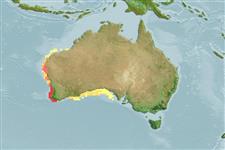分类 / Names
俗名 | 同种异名 | Catalog of Fishes(属, 种) | ITIS | CoL | WoRMS | Cloffa
Environment: milieu / climate zone / depth range / distribution range
生态学
海洋 礁区鱼类; 深度上下限 10 - 60 m (Ref. 57886).
分布
国家 | FAO区域 | 生态系 | 标本纪录 | Point map | 简介 | Faunafri
Eastern Indian Ocean: Western Australia.
大小 / 重量 / 年龄
Maturity: Lm ? range ? - ? cm
Max length : 10.2 cm SL 雄鱼/尚未辨别雌雄; (Ref. 57886); 11.8 cm SL (female)
简单描述
检索表 | 型态特徵 | 形态测量图
背的软条 (总数) : 104 - 110; 臀鳍软条: 66 - 73; 脊椎骨: 53 - 56. The species is characterized by having a very elongate body; vertebrae 16-17 + 36-40 = 53-56, dorsal fin rays 104-110, anal fin rays 66-73, D/A 41-43, V/A 19-20; scales present on body; no supraorbital pore behind eye; lower preopercular pores 3, non-tubular; posterior infraorbital pores 3; broad angle on ventral maxilla positioned behind rear of eye; exposed opercular
spine bent upwards; lower lip with skin folds; single pair of pseudoclaspers curved, hockey stick-like, thin; penis slightly shorter than pseudoclaspers, with hook at tip; otoliths pointed anteriorly and posteriorly, their predorsal and postdorsal angles are similar in expression, otolith length to height ratio 2.1-2.2, with sulcus narrow (Ref. 57886).
Life cycle and mating behavior
Maturities | 繁殖 | Spawnings | Egg(s) | Fecundities | 仔鱼
Møller, P.R. and W. Schwarzhans, 2006. Review of the Dinematichthyini (Teleostei, Bythitidae) of the Indo-west Pacific, Part II. Dermatopsis, Dermatopsoides and Dipulus with description of six new species. The Beagle 22:39-76. (Ref. 57886)
人类利用
工具
特别资料
下载 XML
网络资源
Estimates based on models
Preferred temperature (Ref.
123201): 16.8 - 22.6, mean 18 °C (based on 44 cells).
Phylogenetic diversity index (Ref.
82804): PD
50 = 0.6250 [Uniqueness, from 0.5 = low to 2.0 = high].
Bayesian length-weight: a=0.00389 (0.00180 - 0.00842), b=3.12 (2.94 - 3.30), in cm total length, based on all LWR estimates for this body shape (Ref.
93245).
营养阶层 (Ref.
69278): 3.4 ±0.5 se; based on size and trophs of closest relatives
Fishing Vulnerability (Ref.
59153): Low vulnerability (10 of 100).
